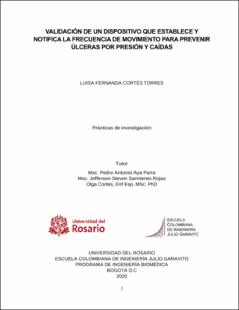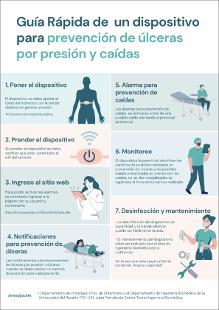Mostrar el registro sencillo del ítem
Validación de un dispositivo que establece y notifica la frecuencia de movimiento para prevenir úlceras por presión y caídas
| dc.contributor.author | Cortés Torres, Luisa Fernanda | spa |
| dc.date.accessioned | 2021-02-05T22:17:19Z | |
| dc.date.accessioned | 2021-10-01T14:29:59Z | |
| dc.date.available | 2021-02-05T22:17:19Z | |
| dc.date.available | 2021-10-01T14:29:59Z | |
| dc.date.issued | 2020 | |
| dc.identifier.uri | https://repositorio.escuelaing.edu.co/handle/001/1350 | |
| dc.description.abstract | This research was developed at the Fundación Cardioinfantil institution, in the line of research on sensors for the prevention of hospital events. To solve two specific problems, pressure ulcers due to long stays in bed, many of the patients in ICUs spend long periods of time in the same position, generating ulcers; as a second problem, institutional falls, where the patient for different reasons loses balance and falls, health personnel are not always informed in time to foresee these events. One of the growth factors of this problem is due to the current situation, which generated higher admissions of patients to the institution and therefore increased hospital events. Both problems can be fatal and the proposed device is expected to prevent these events. Course objective: To validate and determine the feasibility of a device that monitors movement changes, in order to be able to use it both for the prevention of falls and pressure ulcers. Methodology: The research practice was divided into two major stages which in turn will be divided into different phases. The first stage will be divided into two phases, a first phase where the project will be defined. In the second phase, three prototypes will be characterized and evaluated, determining the ideal device for the development of the research. Once the device is defined, the second stage begins, where the operation and feasibility of the device will be evaluated in four phases. In the first phase of stage two, the sensitivity of the device will be validated with a goniometer. In a second phase, the operation of the device will be validated in volunteers. In a third phase, the alarms for prevention of falls and the notifications of change of position for pressure ulcers will be validated with volunteers in a simulated environment. In a fourth phase, the feasibility of the device in patients in hospitalization and ICU will be analyzed. Results: Three prototypes were compared in order to select one and, according to the selected prototype, six identical devices were made, in the second stage four phases were carried out to determine the feasibility of the selected device, for this, sensitivity tests were carried out with goniometer, tests to determine the frequency of change of position in healthy adults during the night, in addition to the successful alarms in prevention of falls. For the feasibility phase with patients, only pressure ulcer prevention tests were performed. | spa |
| dc.format.mimetype | application/pdf | spa |
| dc.language.iso | spa | spa |
| dc.subject | Aplicación IoT | spa |
| dc.subject | Arquitectura IoT | spa |
| dc.subject | Base de datos | spa |
| dc.subject | Caídas | spa |
| dc.subject | Factibilidad | spa |
| dc.subject | IMU | spa |
| dc.subject | Úlceras por presión | spa |
| dc.title | Validación de un dispositivo que establece y notifica la frecuencia de movimiento para prevenir úlceras por presión y caídas | spa |
| dc.title.alternative | Validation of a device that establishes and reports the frequency of movement to prevent pressure ulcers and falls | spa |
| dc.type | Trabajo de grado - Pregrado | spa |
| dc.thesis.discipline | Ingeniería Biomédica | spa |
| dc.thesis.grantor | Sarmiento Rojas, Jefferson (dir) | spa |
| dc.thesis.grantor | Aya Parra, Pedro Antonio (co-dir) | spa |
| dc.thesis.level | Pregrado | spa |
| dc.thesis.name | Ingeniera Biomédica | spa |
| dc.type.version | info:eu-repo/semantics/publishedVersion | spa |
| dc.identifier.doi | https://repositorio.escuelaing.edu.co/handle/001/1350 | |
| dc.rights.accessrights | info:eu-repo/semantics/openAccess | spa |
| dc.type.content | Text | spa |
| dc.type.dcmi-type-vocabulary | Text | spa |
| dc.type.driver | info:eu-repo/semantics/bachelorThesis | spa |
| dc.description.resumen | La presente investigación fue desarrollada en la institución Fundación Cardioinfantil, en la línea de investigación de sensores para prevención de eventos hospitalarios. Para solucionar dos problemáticas puntuales, las úlceras por presión debido a largas estancias en cama, en las UCI muchos de los pacientes duran prolongados periodos de tiempo en la misma posición generando úlceras; como segunda problemática, las caídas institucionales, donde el paciente por diferentes motivos pierde el equilibrio y cae, no siempre el personal de la salud es informado a tiempo para prever estos eventos. Uno de los factores de crecimiento de esta problemática se debe a la coyuntura actual, la cual genero mayores ingresos de pacientes a la institución y por ende aumentaron los eventos hospitalarios. Ambas problemáticas pueden llegar a ser mortales y con el dispositivo propuesto se espera prevenir estos eventos. Objetivo general: Validar y determinar la factibilidad de un dispositivo que monitorea los cambios de movimiento, con el fin de poder usarlo tanto para prevención de caídas como de úlceras por presión. Metodología: La práctica de investigación se dividió en dos grandes etapas las cuales a su vez se dividirán en diferentes fases. La primera etapa se dividirá en dos fases, una primera fase donde se definirá el proyecto. En la segunda fase se caracterizarán y evaluarán tres prototipos, determinando el dispositivo idóneo para el desarrollo de la investigación. Definido el dispositivo se comienza con la segunda etapa, donde se evaluará el funcionamiento y factibilidad del dispositivo en cuatro fases. En una primera fase de la etapa dos se validará la sensibilidad del dispositivo con un goniómetro. En una segunda fase se validará el funcionamiento del dispositivo en voluntarios. En una tercera fase se validará las alarmas para prevención de caídas y las notificaciones de cambio de posición para úlceras por presión con voluntarios en un ambiente simulado. En una cuarta fase se analizará la factibilidad del dispositivo en pacientes en hospitalización y UCI. Resultados: Se compararon tres prototipos con la finalidad de seleccionar uno y de acuerdo con el prototipo seleccionado se realizaron seis dispositivos iguales, en la segunda etapa se realizaron cuatro fases para la determinar la factibilidad del dispositivo seleccionado, para ello se realizaron pruebas de sensibilidad con goniómetro, pruebas para determinar la frecuencia de cambio de posición en adultos sanos durante la noche, además de las alarmas exitosas en prevención de caídas. Para la fase de factibilidad con pacientes solo se realizaron las pruebas para prevención de úlceras por presión. | spa |
| dc.subject.keywords | IoT Application | spa |
| dc.subject.keywords | IoT Architecture | spa |
| dc.subject.keywords | Database | spa |
| dc.subject.keywords | Falls | spa |
| dc.subject.keywords | Feasibility | spa |
| dc.subject.keywords | IMU | spa |
| dc.subject.keywords | Pressure Ulcers | spa |
Ficheros en el ítem
Este ítem aparece en la(s) siguiente(s) colección(ones)
-
BA - Trabajos Dirigidos de Biomédica [232]
Trabajos del Pregrado de Ingeniería Biomédica de la Escuela Colombiana de Ingeniería Julio Garavito












